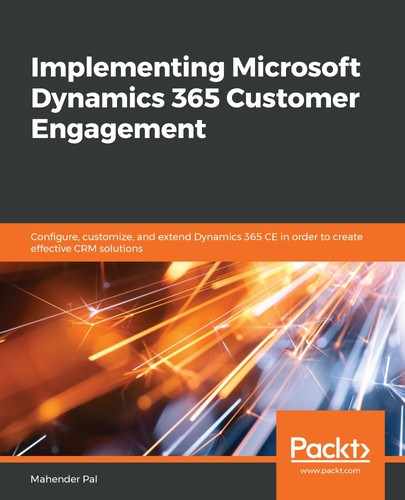After Dynamics CRM 2016 update 8.1 (in earlier versions, it was known as Dynamics CRM), we got the service update 8.2 release and Microsoft rebranded Dynamics CRM to Dynamics 365 CE. Just like other versions, Dynamics 365 did not come with a major release but with a service update for their online customers that was applied to on-premise customers as well. Dynamics 365 CE is a combination of sales, marketing, customer service, field service, project service apps, and other services. It is a new generation intelligence CRM application. All first-party apps, such as Sales, Marketing, Customer Service, Field Service, and Product Service Automation, are highly customizable and extendable, and all these apps provide out-of-the-box integration support for different Microsoft projects, such as SharePoint, OneNote, Microsoft Flow, Power BI, Azure, and Microsoft Teams. Using its out-of-the-box service support, it can be integrated with any other application if we write custom code or use customer connectors.
Dynamics 365's inbuilt business intelligence capability gives you real data insights and helps you make data-driven decisions. Dynamics 365 also utilizes Power BI and AI capabilities to provide real-time data insights that help you make logical business decisions.
Dynamics 365 CE is now part of the Power Platform. Basically, the Power Platform is a web and mobile application development platform that utilizes the capability of Azure Cloud Services. All the Dynamics 365 CE first-party apps are developed using the same platform. Dynamics 365 CE not only provides end-to-end solutions to boost your sales, manage your marketing activities effectively, and provide a personalized customer service experience to your customers, but we can use its Power Platform capabilities to develop customized apps that cater to your specific business needs. These apps can be used across various devices (such as mobiles, tablets, and desktops), which increases their user adaptability.
The Power Platform includes the following three main applications:
- Power Apps: Provides us with a visual designer so that we can design our apps using rich Power Apps controls. We can also use this to connect to different business applications. We can build two types of apps in Power Apps. We will discuss this in more detail in Chapter 8, Integrating Dynamics 365 CE with Other Applications.
- Power Automate: Helps us develop a workflow so that we can automate our activities. We can also connect to different applications using hundreds of connectors in just a few clicks. We will be working with Power Automate in Chapter 8, Integrating Dynamics 365 CE with Other Applications.
- Power BI: Is the next-generation business intelligence app that provides users with an interactive experience so that they can get and share data insights across your organization. We will be working with Power BI in Chapter 9, Business Intelligence and Reporting.
While discussing the Power Platform, some other important terminologies I want to mention are CDM and Common Data Service (CDS). CDM is where we can store our data in different common business entities. These business entities include common business entities such as account, contact, and lead opportunity, but, if required, we can create new custom entities and extend existing entities. Further, data that's stored in these entities can be shared with different applications. CDS allows us to store data in business entities based on the CDM. We can use CDS to build an application in Power Apps. When creating an application in Power Apps, CDS helps us set database, security, and business logic for our application.
